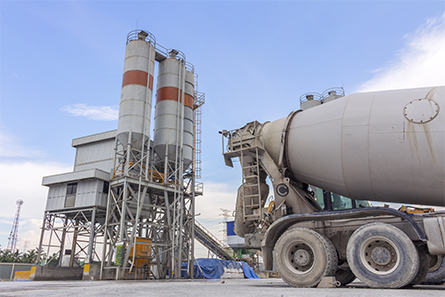Tiny algae could help fix concrete’s dirty little climate secret
Humans produce more concrete than any other material on the planet. It is the literal foundation of modern civilization — and for good reason.
Concrete is strong, durable, affordable and available to almost every community on the planet. However, the global concrete industry has a dirty little secret — it alone is responsible for more than 8% of global carbon dioxide emissions — more than three times the emissions associated with aviation. Those emissions doubled in the past two decades as Asian cities grew, and demand is continuing to expand at an unprecedented rate.

It’s also one of the most difficult industries to decarbonize, in part because manufacturers are typically hyperlocal and operate on slim margins, leaving little to invest in technologies that could lower emissions.
However, difficult does not necessarily mean impossible.
Architects, engineers, scientists and cement and concrete manufacturers around the world are investigating and piloting several new strategies and technologies that can significantly reduce the carbon footprint of cement and concrete. Here are a few of them, including one my team at the University of Colorado is working on: figuring out ways to use all-natural microalgae to solve concrete’s biggest emissions problem — cement.
It doesn’t have to be 100% cement
The primary culprit behind concrete’s climate impact is the production of portland cement — the powder used to make concrete.
Cement is made by heating limestone rich in calcium carbonate to over 2,640 degrees Fahrenheit (1,450 Celsius). The calcium carbonate decomposes into calcium oxide, or quicklime, and carbon dioxide — a climate-warming greenhouse gas. This chemical reaction, what the Portland Cement Association calls a “chemical fact of life,” is responsible for a whopping 60% or so of cement-related emissions. The remainder comes from energy to heat the kiln.
One of the most promising short-term strategies for reducing concrete’s carbon footprint uses materials like fly ash from coal plants, slag from iron production, and calcined clay to replace some of the portland cement in concrete mixtures. These are known as supplementary cementitious materials.
Using 20% to 50% fly ash, slag or calcined clay can reduce the embodied carbon of concrete mixtures by about the same percentages.
Another method uses small amounts of ground limestone to replace some of the cement and is becoming a best practice. After rigorous testing, the California Department of Transportation recently announced it would allow portland–limestone cement mixes, known as PLC, in its projects. With 5% to 15% ground limestone replacing cement, PLC can reduce emissions by about the same amount. California’s decision quickly led other states to approve the use of PLC.
Many researchers are now advocating for the adoption of limestone calcined-clay cement, which contains about 55% portland cement, 15% ground limestone and 30% calcined clay. It could cut emissions by more than 45%.
What electrification and carbon capture can do
Cement plants have also started testing carbon capture technologies and electric kilns to slash emissions. But carbon capture is expensive, and scaling the technology to meet the demand of the cement and concrete industry is no easy feat.
Kiln electrification faces the same barriers. New technologies and large capital investments are required to electrify one of the world’s most energy-intensive processes. However, the promise of zero combustion-related emissions is enticing enough for some entrepreneurs and cement companies — including those interested in using 100% solar energy for cement production — who are racing to find solutions that are both technologically and economically viable at scale.
The Inflation Reduction Act, which Congress passed in August 2022, could help put some of these technologies to wider use. It includes funding for modernizing equipment and adding carbon capture capabilities, as well as tax credit incentives for manufacturers to cut their emissions.
Going cement-free, possibly with algae
Another strategy is to produce functionally equivalent materials that contain no portland cement whatsoever.
Materials like alkali-activated slag or fly ash cement concrete are produced by combining slag, fly ash or both with a very strong base. These materials have been shown to cut carbon emissions by 90% or more, and they might meet scale and cost criteria, but they still face technical and regulatory challenges.
Some examples of low-carbon, portland cement-free concrete products that have gained market traction include wollastonite-based modular components, compressed earth blocks and prefabricated biocement products – including those produced using photosynthetic, biomineralizing microalgae.
Algae have also been used as an alternative biofuel for heating cement kilns, and algae cultivation systems have also been linked with cement production to capture carbon.
My team at the University of Colorado Boulder and I are looking into the use of algae-derived limestone for portland cement production, which could help eliminate 60% of the emissions associated with cement manufacturing. This technology is appealing because it is plug-and-play with conventional cement production.
Using concrete to lock captured CO2 away
Engineers are also experimenting with injecting captured carbon dioxide into concrete as well as using aggregates made of carbon dioxide in place of gravel or sand that is mixed into concrete.
It’s an exciting concept, but so far injection has yielded limited carbon dioxide reductions, and production of carbon-dioxide-storing aggregates has yet to scale up.
A growing problem
Ultimately, time will tell whether these and other technologies will live up to their promise.
What is certain is that there has been a worldwide reckoning within the cement and concrete industry that it has a problem to solve and no silver bullet solution. It may take a suite of solutions tailored to both local and global markets to address the immediate and long-term challenges of keeping up with an ever-growing population and rapidly changing climate.
This article is republished from The Conversation under a Creative Commons license. Read the original article.
![]()
Enjoy reading ASBMB Today?
Become a member to receive the print edition four times a year and the digital edition monthly.
Learn moreGet the latest from ASBMB Today
Enter your email address, and we’ll send you a weekly email with recent articles, interviews and more.
Latest in Science
Science highlights or most popular articles

Mapping proteins, one side chain at a time
Roland Dunbrack Jr. will receive the ASBMB DeLano Award for Computational Biosciences at the ASBMB Annual Meeting, March 7–10, just outside of Washington, D.C.

Exploring the link between lipids and longevity
Meng Wang will present her work on metabolism and aging at the ASBMB Annual Meeting, March 7-10, just outside of Washington, D.C.

Defining a ‘crucial gatekeeper’ of lipid metabolism
George Carman receives the Herbert Tabor Research Award at the ASBMB Annual Meeting, March 7–10, just outside of Washington, D.C.

The science of staying strong
Muscles power every movement, but they also tell the story of aging itself. Scientists are uncovering how strength fades, why some species resist it and what lifestyle and molecular clues could help preserve muscle health for life.

Bacteriophage protein could make queso fresco safer
Researchers characterized the structure and function of PlyP100, a bacteriophage protein that shows promise as a food-safe antimicrobial for preventing Listeria monocytogenes growth in fresh cheeses.

Building the blueprint to block HIV
Wesley Sundquist will present his work on the HIV capsid and revolutionary drug, Lenacapavir, at the ASBMB Annual Meeting, March 7–10, in Maryland.

